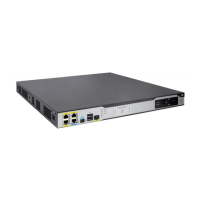178
Syntax
snmp-agent local-engineid engineid
undo snmp-agent local-engineid
Default
The engine ID of a device is the combination of the company ID and the device ID. The device ID
varies by device model.
Views
System view
Predefined user roles
network-admin
Parameters
engineid: Specifies an SNMP engine ID, a hexadecimal string. Its length is an even number in the
range of 10 to 64. All-zero and all-F strings are invalid.
Usage guidelines
An SNMP engine ID uniquely identifies a device in an SNMP managed network. Make sure the local
SNMP engine ID is unique within your SNMP managed network to avoid communication problems.
If you have configured SNMPv3 users, change the local SNMP engine ID only when necessary. The
change can void the SNMPv3 usernames and encrypted keys you have configured.
Examples
# Set the local SNMP engine ID to 123456789A.
<Sysname> system-view
[Sysname] snmp-agent local-engineid 123456789A
Related commands
display snmp-agent local-engineid
snmp-agent usm-user
snmp-agent log
Use snmp-agent log to enable SNMP logging.
Use undo snmp-agent log to disable SNMP logging.
Syntax
snmp-agent log { all | authfail | get-operation | set-operation }
undo snmp-agent log { all | authfail | get-operation | set-operation }
Default
SNMP logging operations are disabled.
Views
System view
Predefined user roles
network-admin
Parameters
all: Enables logging SNMP authentication failures, Get operations, and Set operations.

